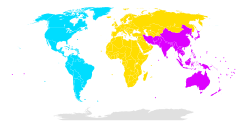23-centimeter band
The 23 centimeter, 1200 MHz or 1.2 GHz band is a portion of the UHF (microwave) radio spectrum internationally allocated to amateur radio and amateur satellite use on a secondary basis. The amateur radio band is between 1240 MHz and 1300 MHz. The amateur satellite band is between 1260 MHz and 1270 MHz, and its use by satellite operations is only for up-links on a non-interference basis to other radio users (ITU footnote 5.282). The allocations are the same in all three ITU regions.[1]
- In the United Kingdom the band is between 1240 MHz and 1325 MHz.[2]
- In Ireland the band is between 1240 MHz and 1304 MHz.
Most modes of communication used in amateur radio can be found in the 23 cm band. Some of the more common modes include voice, data, EME (moonbounce), as well as ATV.[3]
History
The 23cm band was born after the World War II, at the International Radio Conference celebrated in Atlantic City, in 1947. The band was defined from 1215 to 1300 MHz and was allocated exclusively for radio amateur use.
In the 1979 World Administrative Radio Conference held in Geneva (WARC-79), the band was reduced to 1240 - 1300 MHz and downgraded to secondary allocation for amateur use. The primary allocation to the radiolocation service has highest priority.
Agenda Item AI-9.1b at the 2023 World Radio Conference (WRC-23) is considering further constraints on 23cm to protect the Radio Navigation Satellite Service (RNSS), which is also a primary user of the band. RNSS systems include Glonass, Compass and Galileo which use this frequency range to supplement their more standard GNSS frequencies.
In November 2023 ITU-R Recommendation M.2164 was published, giving guidance for amateur and amateur satellite usage.
List of notable frequencies

Frequencies in the 23 cm band are harmonized by International Telecommunication Union region.
Region 1
Region 2
Region 3
- FM Simplex Calling Frequency is 1294.0 MHz (VK Australian band-plan 2007)
In 2008 the IARU Region-1 Cavtat Conference designated 1240.000-1240.750 MHz as an alternative centre for narrowband activity and beacons. This is a mitigation for sharing with existing aviation radars and Primary users, or for potential issues with the European Galileo system.
See also
References
- ^ "FCC Online Table of Frequency Allocations" (PDF). 47 C.F.R. Federal Communications Commission. August 13, 2015. Retrieved October 27, 2015.
- ^ "RSGB Band Plan". Radio Society of Great Britain. Radio Society of Great Britain. 1 January 2023.
- ^ American Radio Relay League's Band Plan for 23cm
- ^ a b "VHF Managers Handbook". 7. International Amateur Radio Union Region 1. January 2015. pp. 45–46. Archived from the original (PDF) on June 17, 2018. Retrieved October 27, 2015.
- ^ a b "IARU Region 2 Band Plan" (PDF). International Amateur Radio Union Region 2. October 14, 2016. pp. 11–12.
- v
- t
- e
| Range | Band | ITU Region 1 | ITU Region 2 | ITU Region 3 |
|---|---|---|---|---|
| LF | 2200 m | 135.7–137.8 kHz | ||
| MF | 630 m | 472–479 kHz | ||
| 160 m | 1.810–1.850 MHz | 1.800–2.000 MHz | ||
| HF | 80 / 75 m | 3.500–3.800 MHz | 3.500–4.000 MHz | 3.500–3.900 MHz |
| 60 m | 5.3515–5.3665 MHz | |||
| 40 m | 7.000–7.200 MHz | 7.000–7.300 MHz | 7.000–7.200 MHz | |
| 30 m[w] | 10.100–10.150 MHz | |||
| 20 m | 14.000–14.350 MHz | |||
| 17 m[w] | 18.068–18.168 MHz | |||
| 15 m | 21.000–21.450 MHz | |||
| 12 m[w] | 24.890–24.990 MHz | |||
| 10 m | 28.000–29.700 MHz | |||
| VHF | 6 m | 50.000–52.000 MHz (50.000–54.000 MHz)[y] | 50.000–54.000 MHz | |
| 4 m[x] | 70.000–70.500 MHz | — | ||
| 2 m | 144.000–146.000 MHz | 144.000–148.000 MHz | ||
| 1.25 m | — | 220.000–225.000 MHz | — | |
| UHF | 70 cm | 430.000–440.000 MHz | 430.000–440.000 MHz (420.000–450.000 MHz)[y] | |
| 33 cm | — | 902.000–928.000 MHz | — | |
| 23 cm | 1.240–1.300 GHz | |||
| 13 cm | 2.300–2.450 GHz | |||
| SHF | 9 cm | 3.400–3.475 GHz[y] | 3.300–3.500 GHz | |
| 5 cm | 5.650–5.850 GHz | 5.650–5.925 GHz | 5.650–5.850 GHz | |
| 3 cm | 10.000–10.500 GHz | |||
| 1.2 cm | 24.000–24.250 GHz | |||
| EHF | 6 mm | 47.000–47.200 GHz | ||
| 4 mm[y] | 75.500 GHz[x] – 81.500 GHz | 76.000–81.500 GHz | ||
| 2.5 mm | 122.250–123.000 GHz | |||
| 2 mm | 134.000–141.000 GHz | |||
| 1 mm | 241.000–250.000 GHz | |||
| THF | Sub-mm | Some administrations have authorized spectrum for amateur use in this region; others have declined to regulate frequencies above 300 GHz. | ||
| [v] All allocations are subject to variation by country. For simplicity, only common allocations found internationally are listed. See a band's article for specifics. | ||||
| See also: Radio spectrum, Electromagnetic spectrum | ||||











